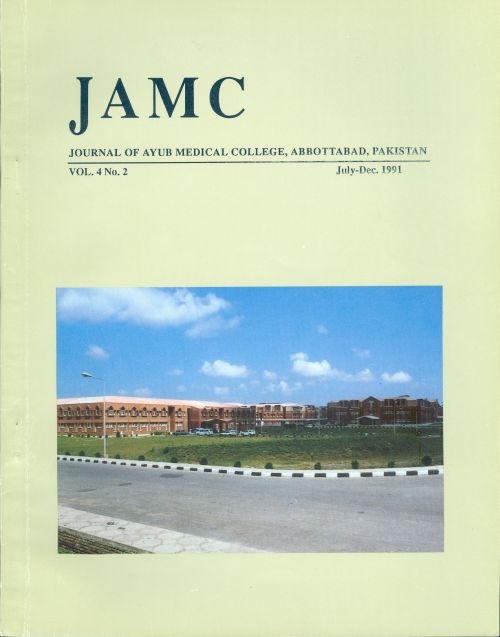A COMPARATIVE STUDY OF VAGINAL PROSTAGLANDIN E2 PESSARIES WITH INTRAVENOUS OXYTOCIN FOR THE INDUCTION OF LABOUR AFTER SPONTANEOUS RUPTURE OF MEMBRANES
Abstract
ABSTRACT:In a prospective randomized study, 60 patients were induced with 3 mg vaginal FE2 pesseries
or intravenous oxytocin.
Oxytocin stimulation was associated with shorter labour and a lower incidence of abnormal
cervimeteric progress, after spontaneous rupture of membranes. Out of these patients given PGE2
20% required a second dose after four hours of slow progress. 10% of primigravida subsequently
developed abnormal labour and required augmentation by oxytocin to correct their uterine
contractions. Two caesarian sections were carried out for disproportion and remaining 58 patients
were delivered vaginally. PGE2 pesseries were not associated with an increased incidence of
hyperstimulation or sepsis. In conclusion oxytocin infusion is a safe, effective but inconvenient
method of induction of labour, while PGE2 pesseries are safe, effective, more acceptable but an
expensive method of induction of labour.
References
Anderson, G.G., Hobbins. J.C., Speroff. L. & Caldwell, B.V. (1972) Intravenous prostaglandin E2 and F2 and
Syntocinon for the induction of term labour J Reprod Med 9, 287-291.
Berkowitz, R.L. (1977) Premature rupture of membranes: a review and treatment plan. Contemp Obstet Gynecol
, 35-40.
Calder, A.A., Embrey, M.P. & Hillier, K. (1974) Extra-amniotic prostaglandin E2 for the induction of labour at
term. J. Obstet Gynaecol Br Commonw 81, 39-46.
Gardozo.L.D., Gibb. d.M.F., Studd. J.W.W., Vasant, R.V. & Cooper, D.J. (1982) Predictive value of cervi- metric
labour patterns in primigravidae. Br J. Obster Gynaecol 89, 33-38.
Evbaldson, G.R., Malmborg, A.-S. & Nord, C.E., (1982) Premature rupture of the membranes and ascending
infection. Br J Obstet Gynaecol 89, 793-801. Gibb, D.M.F., Gardozo, L.D., Studd, J.W.W., Magos, A.L. &
Cooper, D.J. (1982) Outcome of spontaneous labour in multigravidae. Br J. Obstet Gynaecol 89,708-711.
Gillibrand, P.N. (1967) Premature rupture of the membranes and prematurity. J Obstet Gynaecol Commonw 74,
-682.
Gunn, G.C., Mishell, D.R. & Morton, D.G. (1970) Premature rupture of the fatal membrane: review. Am J. Obstet
Gynaecol 106, 469483.
Hauth, J.C., Cunningham, F.G. & Whaley, PJ. (1977) Early labour initiation with oral PGE2 after premature
rupture of the membranes at term Obstet Gynaecol 49, 523-526.
Hefni, M.A., & Lewis, G.A., (1980) Induction of labour with vaginal prostaglandin E2 pessaries. Br J Obstet
Gynaecol 87, 199-202.
Johnson, J.W.C. & Barnes, A.C., (1970) Premature rapture of the membranes: 14 years' experience. Int J Obstet
Gynaecol 8, 251.
Lange, A.P., Secher, N.J., Nielsen, F. H. & Pederson, G.T. (1981) Stimulation of labor in cases of premature
rupture of the membranes at or near term: a consecutive randomized study of prostaglandin E2 tablets and
intravenous oxytocin. Acta Obstet Gynaecol Scand 60, 207-210.
Leading Article (1979) Premature rupture of the membranes. Br. Med ji, 1165-1166.
Nelson, G. H. & Bryans, C.I., (1976) A comparison of oral prostaglandin E2 and intravenous oxytocin for
induction of labor in normal and high-risk pregnancies, am J Obsret Gynecol 126, 549-554.
Rovinsky, J.J. & Shapiro, W.J. (1968) Management of premature rupture of membranes. I. Near term. Obster
Gynecol 32, 855-866.
Studd, J.W.W. (1973) Partograms and nomograms of cervical dilatation in management of primigravida labour.
Br Med J ii, 451-455.
Downloads
How to Cite
Issue
Section
License
Journal of Ayub Medical College, Abbottabad is an OPEN ACCESS JOURNAL which means that all content is FREELY available without charge to all users whether registered with the journal or not. The work published by J Ayub Med Coll Abbottabad is licensed and distributed under the creative commons License CC BY ND Attribution-NoDerivs. Material printed in this journal is OPEN to access, and are FREE for use in academic and research work with proper citation. J Ayub Med Coll Abbottabad accepts only original material for publication with the understanding that except for abstracts, no part of the data has been published or will be submitted for publication elsewhere before appearing in J Ayub Med Coll Abbottabad. The Editorial Board of J Ayub Med Coll Abbottabad makes every effort to ensure the accuracy and authenticity of material printed in J Ayub Med Coll Abbottabad. However, conclusions and statements expressed are views of the authors and do not reflect the opinion/policy of J Ayub Med Coll Abbottabad or the Editorial Board.
USERS are allowed to read, download, copy, distribute, print, search, or link to the full texts of the articles, or use them for any other lawful purpose, without asking prior permission from the publisher or the author. This is in accordance with the BOAI definition of open access.
AUTHORS retain the rights of free downloading/unlimited e-print of full text and sharing/disseminating the article without any restriction, by any means including twitter, scholarly collaboration networks such as ResearchGate, Academia.eu, and social media sites such as Twitter, LinkedIn, Google Scholar and any other professional or academic networking site.










